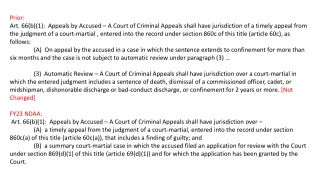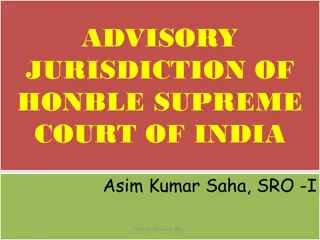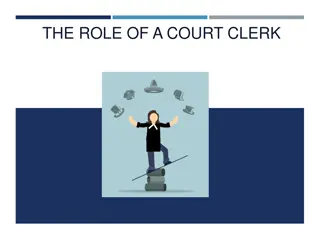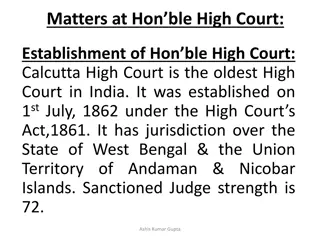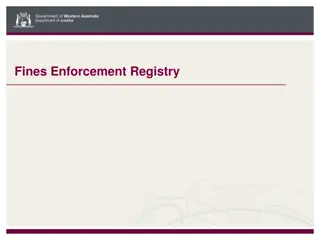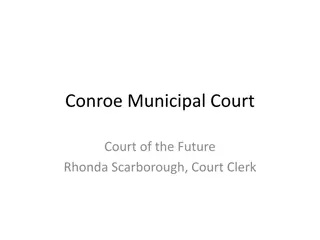
Effective Court Station Management Strategies for Improved Case Flow
Explore the management of court stations, best practices, and key strategies for efficient case flow management. Learn about the importance of timely case disposal, fair adjudication, and the challenges faced in the process.
Download Presentation

Please find below an Image/Link to download the presentation.
The content on the website is provided AS IS for your information and personal use only. It may not be sold, licensed, or shared on other websites without obtaining consent from the author. If you encounter any issues during the download, it is possible that the publisher has removed the file from their server.
You are allowed to download the files provided on this website for personal or commercial use, subject to the condition that they are used lawfully. All files are the property of their respective owners.
The content on the website is provided AS IS for your information and personal use only. It may not be sold, licensed, or shared on other websites without obtaining consent from the author.
E N D
Presentation Transcript
Introduction and layout Introduction and layout 1. Overview of management of court stations 2. Management of Court stations 3. Best Practices in Court station management 4. Case flow management 5. Importance of efficient case flow management 6. Strategies for effective case flow management 7. Challenges in case flow management 2
Overview Overview of of mana manag gemen ement t of of c court ourt stat stati ions ons 1. The management of courts in Uganda is done through a structure. This is the structure of the Judiciary as laid down in the Constitution and other related laws. 2. Management of courts entails judicial administration, leadership, application of processes and procedures in a legal setting to address the needs of communities through timely and expeditious case disposal, Providing fairness and equality in an environment founded on integrity to ensure access to our courts by everyone 3
C Court ourt stat stati ions ons mana manag gemen ement t 1. Key management functions: a) Human resource allocation b) Budget and resource management c) Infrastructure and logistics d) Registry management e) Adjudication of cases f) The inspectorate function of a judicial officer 4
Best practices in court station management Best practices in court station management 1. Staff training and capacity building 2. Implementation of performance management systems 3. Adequate financial and logistical planning 4. Stakeholder engagement and collaboration 5. Open communication 6. Management of a registry 7. Case file management 8. Use of technology 9. Supervision 5
Case flow Case flow mana manag gemen ement t 1. Definition and significance of case flow management E Ef ffi fic ci ie en nt t case o on n th the e p pa ar rt t of of t th he e l li iti tiga by by th the e cou cour rt t us case flow flow m ma an na age geme men nt t is is a ai im me ed d a at t mi gan nt t, , st stre rea am ml lini inin ng g th the e pr pro oce min ni im mi iz zi in ng g t the ces sse ses s a at t t the he d de elays he co cou urt rt for lays , , reduce reduce cos for eas easy y a ac cc ce es ss s cost ts s user ers s. . 2. Stages of case flow: a) b) c) d) e) Filing and registration Pre-trial management Hearing and adjudication Judgment and execution Achieving 6
Key factors in case flow Key factors in case flow mana manag gemen ement t 1.Case assessment majorly on what is required and create appropriate case management strategies. 2.Scheduling and creating realistic time frames. 3.Keep the file / case active by regular monitoring to detect unnecessary delays and address any procedural issues that may arise. 4.Track progress on a daily to avoid creating backlog and efficient 5.Manage documents/ system. Use technology as much as possible 6.Regular stakeholder engagement especially those that are involved in court processes 7.Set realistic goals and targets 7
Strategies for effective case flow management Strategies for effective case flow management 1. Use of Alternative Dispute Resolution (ADR) 2. Adoption of case management tools (ECCMIS, CCAS, cause lists, and adoption of technologies like artificial intelligence (AI)) 3. Strengthening judicial capacity and court automation. 4. Strict adherence to case time standards 8
Challenges in case flow Challenges in case flow mana manag gemen ement t 1. Case backlog and delays 2. Limited judicial officers and support staff 3. Logistical and infrastructural constraints 4. Poor coordination among stakeholders 5. Identification of inefficiencies in case flow and making recommendations 9
Data Data mana manag gemen ement in courts t in courts 1. Definition and role of datamanagement in judicialoperations Da Dat ta a mana manag ge em me en nt t i is s t th he e p pr ro oc ce ess ss, , p pra racti a an nd d st stor ore e it it. . ctic ce es s, , t te ec ch hno nol lo og gi ie es s u us se ed d t to o c co ol ll le ec ct t d da at ta a 2. The role of data management a)It s the only way to manage the life cycle of the case. b)Accessibility of the data in our custody file for example the judgements and court record c)Helps in accurate reporting. Note: standards have to be put electronically or manually to have accurate data d)Ensure privacy and datasecurityof court data e)The processes of how to access, collect, retain, achieve and destroy the court records. 10
Data Data mana manag gemen ement in courts t in courts Key components: 1. Case records management 2. Digital transformation and automation 3. Data security and confidentiality 4. Data storage and retrival 11
Definition and role of data Definition and role of data mana manag gemen ement t 1. Easy access to court documents 2. Use in decision making and policy making 3. Quick disposal of cases as you know the status of the information with you 4. Discovering bottlenecks in the Court system 5. Understanding the trends of the Court 12
Challenges in court data Challenges in court data mana manag gemen ement t 1. Poor record-keeping practices 2. Inadequate ICT infrastructure 3. Loss and misplacement of files 4. Archival issues 5. Resistance to digital transformation 6. Lack of transperancy in the processesof data management 7. Intergrity of the data especially for data that is transformed from paper to digital 8. Inconsistences in entering the data can affect efficiency and cause problems 9. Lack of adequate training in data management and handling 13
Solutions for effective data Solutions for effective data mana manag gemen ement t 1. Secure and organize files 2. Use technology like ECCMIS and CCASS to improve efficiency 3. Manage court schedules effectively. 4. Train and supervise staff. 5. Manage and monitor the engine of the court which is the registry 14
Conclusion Conclusion Summary of key points: 1. 2. 3. Efficient management of court stations enhances service delivery Case flow management reduces backlog and delays Data management ensures transparency, accountability, and efficiency All this is aimed at building public confidence in your Court . Effective court management, seamless case flow, and robust data systems are the pillars of a responsive judiciary. Let s commit to excellence in justice administration" 15
Questions Questions 16

